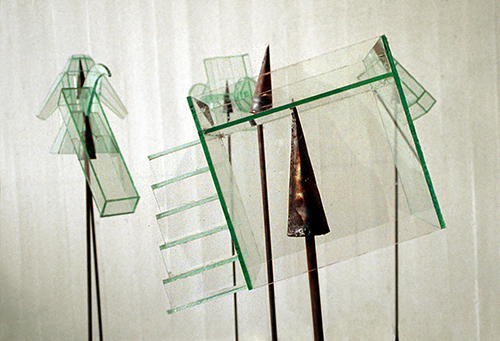Four x 4
Roger Palmer
Early in 1991 the artist made nine small objects which were roughly constructed of clear glass, their green edges prominent at each angle and joint. Some are immediately recognisable as representations of ·real’ things: a two wheeled cart, a waisted dress, a simple rectilinear building with an outside stairway attached giving access to its flat roof. Others offer less certain clues towards identification – an electric fan, or maybe it is a windmill; a set of bongo drums, or is this a pair of tapered trousers to be worn under the dress? What appears to be a shark’s fin protruding from an elongated block could be a blade embedded in a solid wooden base.
Whilst each object describes a discreet item with its own scale, form and function, all nine exist here as equals, as if dislocated and distanced from their original source through the disorder of memory. As potentially handleable glass structures, their strongest formal association in an urban Western culture might be with the terrarium, as a miniature exotic garden. As components of a sculpture by Permindar Kaur, these glass objects are presented as recent arrivals from another culture, another place.
The nine glass objects are supported by arrows (or are they spears ?) which are embedded in the wooden floor of the artists’ studio. This chest high balancing act of glass on sharpened steel creates a dangerous arrangement of stakes through which the visitor is invited to pass with great care. One’s attention is divided between the top-heavy, swaying uprights and the fragile, transparent forms that are delicately balanced on each palisade. As an alternative strategy, the artist places her glass objects on the floor, each one beside the still embedded point of an arrow. Now a different relationship exists between the volley of arrows and their unloaded cargoes. With sharp conical points at both ends of their shafts, the arrows carry an expectation of impending departure, ready to travel empty on the return night. The glass objects await distribution and absorption in their new locale.
Permindar Kaur’s art can be understood as a thoughtful and delicate synthesis of the different cultural experiences that she is simultaneously immersed in. She may think of herself as both an Indian and a British woman, with strong ties to the Punjab and the English Midlands. On the other hand she may feel that she is always on the periphery, with a sense of displacement in both of the places that might be called “home”. Her work is informed by two cultures, with her Indian roots providing the thematic core as well as a source of imagery which is largely drawn from memory. As a British sculptor with a Fine Art degree from Sheffield Polytechnic Permindar is well aware of a European critical context which informs her work and the developments that occur in ‘international’ (Western) contemporary art.
Through her regular use of contrasting materials (glass/steel, steel/clay, clay/glass), Permindar offers to the viewer a set of precise formal relationships in which the distinctions between the familiar and the unfamiliar, image and substance, begin to blur. In her sculpture she chooses to explore and articulate some of the problems and pressures of cultural fragmentation. The strength of her work lies in its capacity to tackle such important issues through a subtle and celebratory manipulation of simple images, materials and spaces.
Roger Palmer is an artist and curator at Glasgow School of Art.
Four × 4 exhibition catalogue (unpaginated).
Curated by Eddie Chambers, 1991. Four x 4 was ‘an innovative exhibition project that brings together sixteen artists creating installations in four different gallery spaces.
Arnolfini, Bristol, 12 October – 24 November 1991
Permindar Kaur, Virginia Nimarkoh, Alistair Raphael, Vincent Stokes
ISBN 0 9513290 1 4
